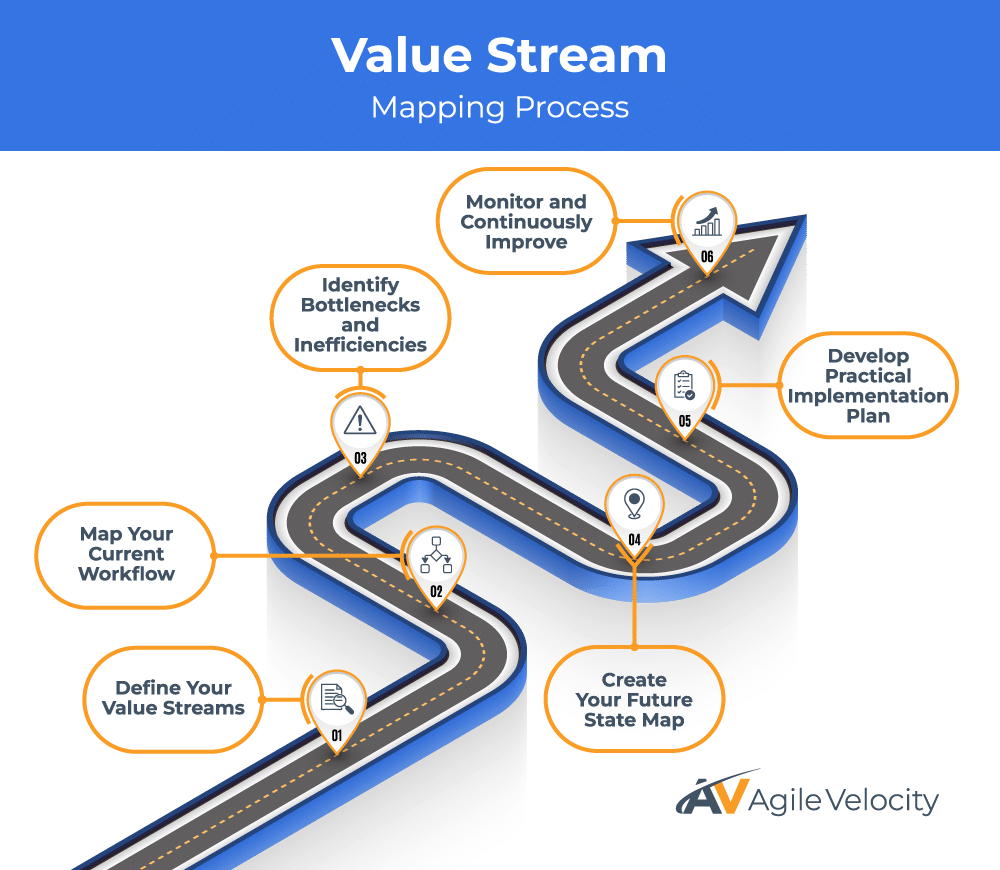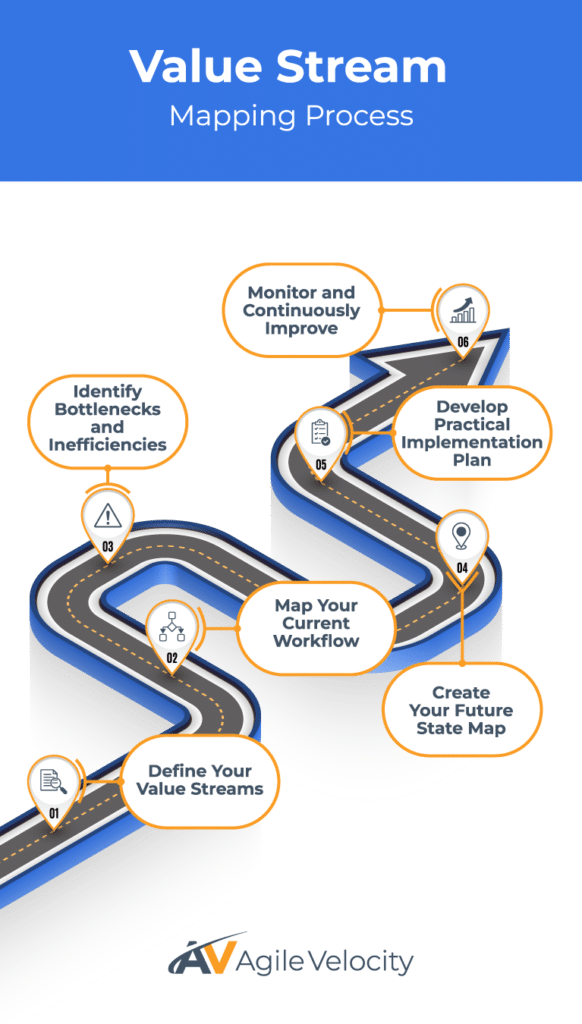Value stream mapping is a powerful technique that enhances collaboration between sales and operations, optimizes workflows, and strengthens organizational agility. In today’s fast-paced business environment, efficiency and alignment are critical. Without them, businesses risk dissatisfied customers and lost opportunities.. With value stream mapping, teams gain clarity on their processes, identify inefficiencies, reduce lead times, and ultimately deliver greater value to customers.
This article explores why value stream mapping is a game-changer for sales and operations teams, offering a practical, six-step guide to get started. You’ll also see how tools like Path to Agility® Navigator empower organizations to move from outdated processes to more streamlined, adaptive workflows. Ultimately, value stream mapping doesn’t just complement Agile Transformation initiatives—it helps sustain continuous improvement at every level.
Value Stream Mapping for Sales and Operations Efficiency
Value stream mapping is a powerful technique that visually captures and analyzes the series of steps involved in delivering a product or service. By focusing on the journey from early sales interactions to operational fulfillment, it uncovers the points that can slow progress or create wasted effort.
Leaders across these teams often chase a central goal: improve efficiency while delivering exceptional customer outcomes. Yet operational silos, handoff miscommunication, and conflicting objectives can derail that mission. Value stream mapping helps organizations refocus on the customer, providing a structure that makes inefficiencies visible and easier to address.
Whether your organization practices Scrum, Kanban, or SAFe®, this technique fits seamlessly. It delivers a comprehensive view of work, helping teams adapt quickly and stay aligned on customer value.
Build High-Performing Teams
Understanding the Core Principles of Value Stream Mapping
At its heart, value stream mapping is about surfacing inefficiency and building a clear path to improvement. A few core principles guide the process:
- Prioritize Customer Value – Every step in your process should anchor on what the customer genuinely needs or expects. Anything else is a candidate for change or removal.
- Visualize the Entire Workflow – A complete overview of the process—from initial inquiry to final delivery—reveals how work moves across different teams. This highlights bottlenecks, handoffs, and potential confusion.
- Eliminate Waste – Inefficiencies can take many forms, from redundant tasks to unclear responsibilities. Identifying and removing these obstacles not only improves speed but also boosts team spirit.
- Promote continuous improvement – One mapping session isn’t enough. Revisiting and refining the process ensures you adapt as customer demands and business environments shift.
- Embrace Agile Iterations – Agile frameworks thrive on continuous improvement. By integrating mapping insights into each cycle, teams can refine their approach and deliver consistent value.
By following these principles, organizations foster a transparent, collaborative culture. Over time, value stream mapping becomes an engine for adaptation and strong outcomes.
Why Value Stream Mapping Is Vital for Sales and Operations Teams
Sales teams focus on driving revenue, while operations ensure efficient delivery and quality. Misalignment between the two can lead to operational silos, inefficiencies, and missed customer expectations. Value stream mapping bridges that gap by creating a unified perspective on how work really happens.
How Value Stream Mapping Bridges the Gap
- Shared Understanding – A visual map of how leads progress to fulfillment uncovers each team’s role. This clarity reduces misunderstandings and duplication of effort.
- Smoother Collaboration – A detailed illustration of handoffs pinpoints exactly where tasks shift between sales and operations. With fewer surprises, teams reduce miscommunications and wasted time.
- Better Predictability – Mapping reveals patterns, letting you plan more accurately and anticipate future demand. This can improve forecasting and resource allocation.
- Customer-Focused Alignment – Teams that see the entire journey—from initial sale to delivery—are more likely to rally around delivering a seamless customer experience.
In practice, this visibility helps organizations spot stale processes and redesign them collectively. The result is smoother operations, more reliable timelines, and a support system for continuous improvement.
Beyond immediate efficiency gains, value stream mapping encourages an ongoing commitment to learning and refinement. Many businesses discover that once they see how work really moves, new ideas for improvement emerge quickly. That openness helps maintain organizational agility for the long haul.
Mastering Value Stream Mapping: A 6-Step Guide to Success
Implementing value stream mapping can feel intimidating at first. To simplify, let’s break it down into six practical steps. While these steps often unfold in sequence, they’re not rigid—teams may revisit them as they discover new insights or market demands shift.


Step 1: Define Your Value Streams
Begin by isolating the specific processes you want to optimize:
- Pinpoint Core Activities – Focus on high-impact processes, such as the lead-to-order pipeline or manufacturing. Prioritize areas likely to yield strong returns on efficiency.
- Collaborate Across Teams – Involve sales, operations, and leadership from the start. Their combined perspective ensures you choose a meaningful and wide-reaching stream.
- Focus on Impact – Select streams where improvement will enhance throughput or customer satisfaction most significantly.
Clearly defining your value streams ensures a focused mapping process, preventing scope creep and misalignment.
Step 2: Map Your Current Workflow
Create a visual map of how work actually progresses:
- Document Each Step – From the moment a prospect comes in contact with your sales team to the fulfillment or delivery point, outline who, what, and how tasks are completed.
- Assign Ownership – Note which roles or teams handle each step, so no one is surprised by how responsibilities are split.
- Assess Tools and Systems – Identify any software automations, manual processes, or spreadsheets that come into play. Each can bring unique advantages—or delays.
A detailed current-state map prevents assumptions, revealing how work actually flows across teams.
Step 3: Identify Bottlenecks and Inefficiencies
Once you’ve documented the “as-is” process, look for trouble spots:
- Spot Delays and Redundancies – Does an approval chain create long stalls? Are multiple teams replicating the same work? Call these out for later action.
- Measure the Impact – If possible, quantify how delays affect speed, quality, or cost. This data helps you set priorities.
- Prioritize Pain Points – Not all issues need immediate fixes. Focus on the most pressing obstacles, especially those with clear connections to customer value or time savings.
Using historical data or performance metrics can reveal hidden bottlenecks and validate improvement opportunities. This insight can uncover hidden bottlenecks that anecdotal evidence might miss.
Step 4: Create Your Future State Map
Now it’s time to envision what the process should look like:
- Streamline Processes – Combine or eliminate steps that no longer serve a purpose. Automate wherever it makes sense and keep your customer’s needs front and center.
- Align With Broader Goals – Tie improvements back to specific business metrics, like faster fulfillment times or improved customer ratings.
- Get Stakeholder Input – Validate proposed changes with team members who will do the work or benefit from it. Early buy-in makes it easier to implement changes later.
In this step, creativity meets practicality. Think about which transformations are feasible and which might require incremental progress over time.
Step 5: Develop a Practical Implementation Plan
A well-defined future state is only valuable if teams can implement it effectively:
- Break Changes into Increments – Even the best ideas fall flat when deployed in one massive leap. Smaller steps allow teams to adapt smoothly.
- Set Clear Milestones – Plan sessions or pilot runs that let you track whether changes are delivering the desired outcomes.
- Assign Responsibilities – Specify who oversees each portion of the transition. Ensure each contributor understands how their work connects to broader goals.
Consider creating an implementation timeline that lays out milestones. This clarity helps maintain momentum and keeps teams focused on short- and long-term wins.
Step 6: Monitor, Adapt, and Continuously Improve
Value stream mapping is never a one-and-done exercise:
- Track Key Metrics – Watching metrics like cycle times and throughput helps you confirm whether your changes are working.
- Foster Feedback Loops – Regular events—like a retrospective—encourage open dialogue about what’s working and what needs refining.
- Strive for Iterative Growth – Each improvement cycle offers insight for the next. Consistent refinement keeps you in tune with evolving business and customer demands.
Whether you’re a small startup or a large corporation, these steps help you integrate value stream mapping into daily operations. They also encourage a mindset that welcomes questions, ideas, and experimentation long after the initial rollout.
Key Benefits of Value Stream Mapping for Business Outcomes

When executed thoughtfully, value stream mapping elevates both internal processes and the customer’s experience. Below are some notable benefits:
- Accelerated Lead Times – Reducing handoffs, wait times, and duplicated tasks helps get products or services to customers faster.
- Increased Throughput – Eliminating unnecessary steps and clarifying responsibilities frees your team to handle higher volumes of work.
- Improved Planning and Forecasting – A clear view into how tasks flow helps you schedule and estimate more accurately.
- Enhanced Team Collaboration and Morale – Transparency about each role’s function often reduces friction and empowers employees to contribute effectively.
- Stronger Alignment Between Sales and Operations – A unified process map can help reduce blame-shifting and foster collaborative problem-solving by clarifying roles and responsibilities.
- Fostering Ongoing Innovation – The habit of mapping and improving naturally extends beyond one process, encouraging new ideas and quick pivots in other areas too.
Value stream mapping turns process ambiguity into structured clarity. By visualizing workflows end-to-end, teams can proactively identify and resolve inefficiencies.
Agile Velocity’s Role in Supporting Value Stream Mapping Success
Agile Velocity specializes in empowering organizations to achieve faster value delivery, drive efficiency, and sustain organizational agility. Core services include Agile Coaching, Lean Portfolio Management, and guidance on SAFe—each critical for effective process overhauls that stick.
A key component is Path to Agility Navigator, which goes beyond simply visualizing the work. This tool supports teams in identifying the most urgent areas for change, tracking progress, and connecting each improvement to recognized business outcomes. Path to Agility Navigator helps you:
- Simplify Prioritization – Easily see which actions will yield the highest impact, so teams don’t waste energy on lower-value tasks.
- Drive Outcome-Oriented Change- Tie each adjustment to clear success metrics like shorter lead times or higher client satisfaction.
- Enable Incremental Improvements – Use incremental adjustments to refine processes without overwhelming your workforce.
On top of technology platforms, Agile Velocity provides team coaching and Agile training that help nurture a culture of continuous improvement. With strong collaboration, clear roles, and data-driven strategies, organizations can keep their improvements sustainable and effective.
Tips for Driving Successful Value Stream Mapping Initiatives
Implementing value stream mapping can reveal sensitive processes and unfamiliar data. Here are some tips to make the journey smoother:
- Champion Openness and Transparency – Encourage open dialogue around obstacles. Hiding issues prolongs inefficiency, so a candid culture unearths problems faster.
- Involve Departments Early – Sales and operations aren’t the only ones affected by long lead times or misplaced resources. Include cross-functional experts who have firsthand knowledge of the workflow.
- Tackle Quick Wins First – Rapid improvements build team morale. Showing visible results early helps galvanize broader support for bigger, more complex changes.
- Offer Training and Guidance – Teach employees the basics of value stream mapping. Help them see it as a shared tool that clarifies processes, rather than an exercise in micromanagement.
- Address Resistance Efficiently – Explain why each shift is happening. Provide support—especially when new tools or approaches replace familiar routines.
- Embrace Ongoing Feedback – Stay open to modifying your plan if the data suggests another route is better. Adaptation keeps your business in sync with customer and market realities.
By following these tips, you build a positive climate where teams feel comfortable exploring new ideas. Over time, people come to see process improvement as a natural part of their role, not a disruptive event forced from above.
Drive Continuous Improvement and Innovation with Value Stream Mapping
Value stream mapping is a powerful way to align sales and operations around a shared mission: delivering greater value to customers. By highlighting inefficiencies and reorienting your workflow to respond directly to customer needs, you reduce friction, optimize collaboration, and hardwire continuous improvement into your everyday process. In the long run, this focus also supports organizational agility and sparks new opportunities for innovation.
Agile Velocity is ready to guide your teams through every stage of the transformation. Through interactive workshops, advanced Agile training programs, and organizational benefits of Path to Agility Navigator, you can move from piecemeal improvements to a fully integrated system that continually adapts to change. Whether you need to overhaul an entire sales-to-operations process or seek targeted coaching for specific teams, Agile Velocity offers the expertise and resources to help you succeed.
Ready to connect your teams, refine your processes, and maximize results? Explore how value stream mapping—and Agile Velocity’s hands-on support—can spark the transformation your organization needs. With a clear plan, supportive culture, and the right tools, you’ll make value stream mapping the foundation for a more collaborative, forward-thinking way of working.



